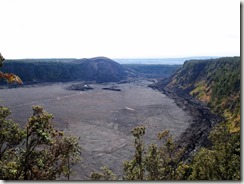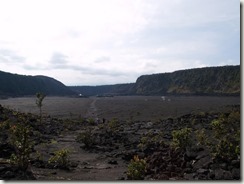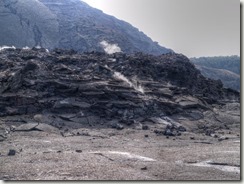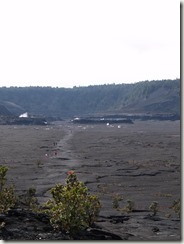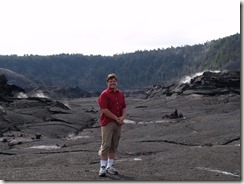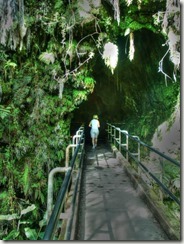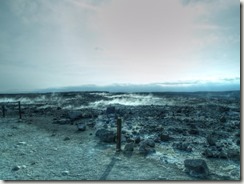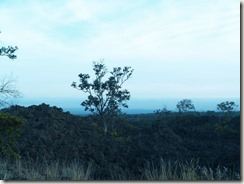Wednesday 4th of April
Continued from Part 1.
We left Whittington Park and headed north towards the town of Volcano. The island treated us to more views of lava mixed with exotic island greenery. The road is quite long, and only occasionally marked by interesting sights.
It wasn’t long (around 40 minutes) before we arrived at our destination. The National Park has a tourist information centre which is littered with information. We bought a poster which we still have today, and made some notes about the sights in the area. Our first stop was the nearby Kilauea Iki, which is a neatly formed and still active pit crater.
The hike down to the floor of the crater was not for the unfit or the faint of heart. Inexperienced hikers would have found the descent (and later the return ascent) quite challenging as the tropical forest made the path difficult to navigate at times.
Once we made it to the crater, we discovered what could pass for another world. A gritty, shale like surface which was warm to the touch, created a home for several types of green plant growing between cracks in lava which was 50 years old.
As we approached the centre of the crater, along a well-worn track made by countless previous guests, we started to recognise sulphur emissions (smells like bad eggs) in addition to the steam venting upwards.
The return hike was just as tough as the descent had been, and all up took about an hour and a half – and we ideally should have taken more water with us then we had. Our next stop were a series of former lava tubes which were located not far away.
The entrance was covered by the same dense tropical forest which occupies most of the area, and we walked the length of what could pass for a crude man made tunnel (based on how big it was). It was a little tricky to photograph without a flash, but what you see here is a fairly accurate portrayal of what it is like inside a lava tube.
Once finished, we continued along Crater Rim drive to get a better look at the Kilauea crater proper. This is a MASSIVE crater.
The photos really don’t do it justice one bit. The crater is huge, and even the crater pit itself is at least about roughly the same size as Kilauea Iki. The road actually takes you down into the crater and along inside.
It was like driving on some alien planet with steam constantly rising out of the cracked lava, and the sky greyed and smoky. The photos simply can’t give you a clear picture of what it was like to be inside this mammoth crater.
We drove the entire length of the rim, stopping at the west rim at the Hawaiian Volcano Observatory for more photos.

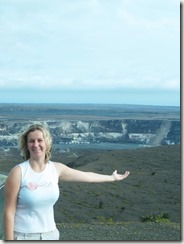
At the Observatory on the western rim, overlooking the Kilauea crater
Now we take an interesting deviation. It was still mid-afternoon by this stage and we had taken heed of some advice – which is to say, we’d heard that the active lava flow is better viewed after sunset.
Therefore, and with time to spare, we decided to backtrack and take a road we had noticed on our way in, which would see us ascend the side of Mauna Loa. Let me say up front: this was a silly idea.
We drove for at least an hour and a half up a single lane (one way) road with few places to pass other cars. As luck would have it a car did come the other way, but right when there was space to pass each other. We passed a number of old lava flows, where the road had been paved across it.
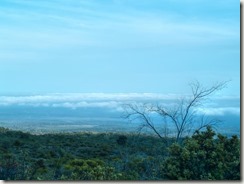

Ascending the side of Mauna Loa
When we finally reached as far as the road would go, the trees and dense forest robbed us of any potential views. There was a fairly decrepit hiker’s hut, but nothing much else worth mentioning.
So with that waste of time complete, we returned back down the mountain without any incidents. At this point, it was close to 6pm, so we drove to the town of Volcano and ate dinner at a little restaurant where the service was a bit slow, but it didn’t bother us, as we were waiting for the sun to set.

Our trek down to the lava flow
Here’s where things go a little bit pear shaped.
Once dinner was over, we drove back to the National Park and wound our way to the edge of the park, following the road as far east as it allowed. By the time we arrived, the sun was on the horizon, and we parked the car near the end of the road.
As we were arriving, many people were returning from their visit to the lava flow. We had been to the Kona Walmart the previous day, and had arrived incredibly ill-equipped with cheap torches, but plenty of water.

Our long and dangerous path out to the active lava flow
By the way – a tip for those would-be adventurers who want to visit the lava flow (and boy we could have used this info!): it’s closer to approach from the EAST. Significantly closer.

A comparison between routes. A is the eastern access, C is the western access. B is the active flow.
“One does not simply walk to a lava flow”
The path to the active lava flow takes ages – it turns out it’s about nine kilometres, but you can’t take a direct line. There’s old lava to cross, and it’s dangerously sharp and can cause flesh wounds if you are unlucky enough to fall onto it.
It’s also not flat. Because it is former lava, there are peaks and troughs, and you have to be able to navigate between them both, since it is ill-advised to try to jump or climb. To help prevent adventurers from getting lost, there are flashing beacons (numbered) lighting the direction to the active flow.
They appeared to be dotted the same distance apart (impossible to tell how far apart) but were often incredibly hard to see if you found yourself in a low-lying crevasse. The final blow was made all the more crushing by our poor choice of cheap flashlights – there was no moon. It was completely covered by cloud cover.
We met up with another American couple who were less prepared than we were. We offered them some water, and we proceeded together out to the lava flow.
It took us just over two hours to make the journey out to the active lava flow, we arrived at about 8:15pm and we almost walked right into the lava. The temperature increases so modestly over the course of a few hours, so you barely notice the heat. The first sign indicator – particularly at night – is that we noticed flowing lava underneath our feet!
We were probably only a few meters away before we had the shocking realisation that we were standing on what could have been a very loose surface, and around that time shock started to set in.
With no help from the moon, photography was painstakingly pointless. Any flash would have flooded the area, and without a tripod, there was no way of supporting the lens for a long shutter snap.
As a result, the photos are positively underwhelming, but in my mind’s eye, I’ll always remember the shock and awe of seeing lava flowing way below my feet, through what appeared to be a transparent ground.
Needless to say… we didn’t dwell too long so close to the lava. The intense sulphur coupled with our alarmingly close proximity to the flow and our inability to correctly measure distances gave us plenty of reasons to start our way back to the car.
It gets worse..
I’d very much like to tell you that this is where the day ended – but it doesn’t end here. It took us four hours to find our way back to the car – confronted by what seemed to be an endless route with heaps of valleys and crests.
We lost track of the beacons several times, and only managed to head in the right direction by keeping the ocean to our left hand side at all times. It was a truly harrowing experience, and in hindsight we should have bought far better torches and more water.
We finally reached the car park a little after MIDNIGHT. Tired and worn out, we started the car and began the journey back out of the National Park.
It gets even worse..
Upon starting the car, the fuel gauge – which had been sitting on half a tank when we arrived – immediately dropped to a quarter of a tank! As our jaws dropped, we began to calculate the odds of finding a petrol station on the south east side of the Big Island after midnight. It didn’t seem likely.

The 167km journey back to Kona
Hurtling back to the west coast..
We cleared the National Park heading south west, deciding against what would have been an hour’s drive to the capital, Hilo. As it turns out, the return trip was a whopping 104 miles (167 kms!) and estimated at 2 hours 41 mins.
To say that we were nervous would be a massive understatement. We hit the road at speed, and made excellent time to Na’alehu (in about 40 mins) clocking up a respectable speed. Just as we were to enter the town, Toni urged me to slow.. and we did, just as we passed a local patrol car.
As expected, no service stations were open, so we accelerated away and continued the trip north east. It was a dark night, and we only had the limited range of the headlights to guide us. The car remarkably seemed to have an inexhaustible supply of fuel despite hovering just above empty.
At last, some luck!
As luck would have it, our fuel continued to last as we screamed north towards Captain Cook. About 9.7 miles (15 kms) from the Sheraton we came across a 24/7 Chevron just inside the town of Captain Cook.
We refuelled the car, finally relieved, and made the rest of the way back to the Sheraton without any further incident. We arrived at the Sheraton a little after 3am and instantly crashed.
You’d have thought we would sleep in well into the next day, but we were rudely awoken by our next door neighbour, who decided to practice kickboxing by punching a punching bag against our common wall at 8am. *sigh*
That was one hell of a day!
To Be Continued – Day 3.

